英语语言学论文
英语语言学 毕业论文
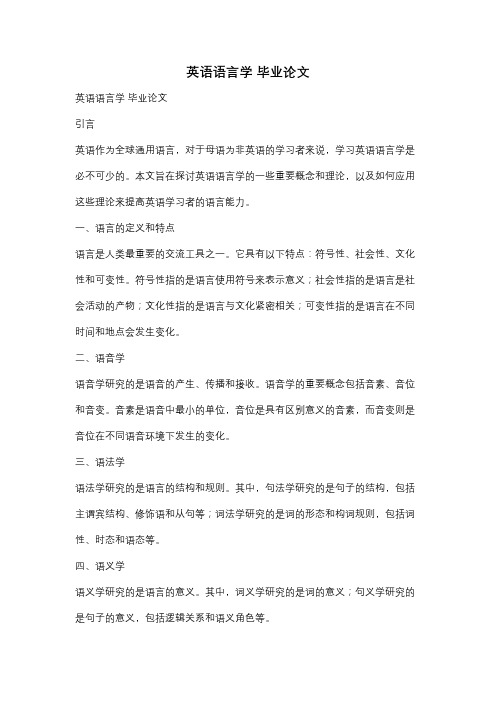
英语语言学毕业论文英语语言学毕业论文引言英语作为全球通用语言,对于母语为非英语的学习者来说,学习英语语言学是必不可少的。
本文旨在探讨英语语言学的一些重要概念和理论,以及如何应用这些理论来提高英语学习者的语言能力。
一、语言的定义和特点语言是人类最重要的交流工具之一。
它具有以下特点:符号性、社会性、文化性和可变性。
符号性指的是语言使用符号来表示意义;社会性指的是语言是社会活动的产物;文化性指的是语言与文化紧密相关;可变性指的是语言在不同时间和地点会发生变化。
二、语音学语音学研究的是语音的产生、传播和接收。
语音学的重要概念包括音素、音位和音变。
音素是语音中最小的单位,音位是具有区别意义的音素,而音变则是音位在不同语音环境下发生的变化。
三、语法学语法学研究的是语言的结构和规则。
其中,句法学研究的是句子的结构,包括主谓宾结构、修饰语和从句等;词法学研究的是词的形态和构词规则,包括词性、时态和语态等。
四、语义学语义学研究的是语言的意义。
其中,词义学研究的是词的意义;句义学研究的是句子的意义,包括逻辑关系和语义角色等。
五、语用学语用学研究的是语言在特定语境下的使用。
它关注的是语言的意图、目的和效果。
语用学的重要概念包括言外之意、语篇和会话分析。
六、二语习得二语习得是指母语为非目标语言的个体学习目标语言的过程。
二语习得的理论有很多,其中最著名的是克鲁斯卡尔的互补分布理论和斯蒂芬·克拉申的监控理论。
七、语言教学语言教学是将语言学理论应用于实际教学中。
语言教学方法有很多种,包括传统的文法翻译法、直接法、听说法和交际法等。
不同的教学方法适用于不同的学习者和教学环境。
八、语言变体和语言变异语言变体是指同一语言在不同社会群体中的变化。
它包括地区变体、社会变体和个人变体。
语言变异是指同一语言在不同时间和地点的变化。
语言变体和变异的研究对于理解语言变化和语言发展具有重要意义。
结论英语语言学是研究英语语言的科学,它涵盖了语音学、语法学、语义学、语用学、二语习得和语言教学等多个领域。
英语语言学毕业论文(精选多篇)
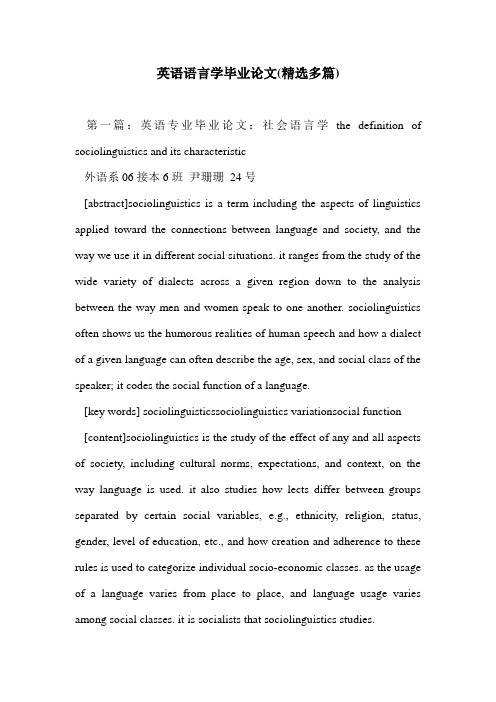
英语语言学毕业论文(精选多篇)第一篇:英语专业毕业论文:社会语言学the definition of sociolinguistics and its characteristic外语系06接本6班尹珊珊24号[abstract]sociolinguistics is a term including the aspects of linguistics applied toward the connections between language and society, and the way we use it in different social situations. it ranges from the study of the wide variety of dialects across a given region down to the analysis between the way men and women speak to one another. sociolinguistics often shows us the humorous realities of human speech and how a dialect of a given language can often describe the age, sex, and social class of the speaker; it codes the social function of a language.[key words] sociolinguisticssociolinguistics variationsocial function [content]sociolinguistics is the study of the effect of any and all aspects of society, including cultural norms, expectations, and context, on the way language is used. it also studies how lects differ between groups separated by certain social variables, e.g., ethnicity, religion, status, gender, level of education, etc., and how creation and adherence to these rules is used to categorize individual socio-economic classes. as the usage of a language varies from place to place, and language usage varies among social classes. it is socialists that sociolinguistics studies.the study of language variation is concerned with social constraints determine language in its contextual environment. code-switching is the term given to the use of different varieties of language in different social situations. sociolinguistic differs from sociology of language in that the focus of sociolinguistics is the effect of the society on the language, while the latter’s focus is on the language’s effect on the society. while the study of sociolinguistics is very broad, there are a few fundamental concepts on which most sociolinguistic inquiries depend. sociolinguistics is different from many of the other branches of linguistics in that it studies external as opposed to internal language. internal language applies to the study of language on the abstract level, or in the head, put simply. external language applies to language in social contexts, or outside the head. this distinction is important, because internal language analyses, such as syntax and semantics, operate1on the assumption that all native speakers of a language are quite homogeneous in how they process and perceive language. external language fields, such as sociolinguistics, attempt to explain why this is in fact not the case. these two approaches, while distinct, complement each other in practice.understanding language in society means that one also has to understand the social networks in which language is embedded. this may apply to the macro level of a country or a city, but also to the inter-personal level ofneighborhoods or a single family.sociolinguistics as a field distinct from dialectology was pioneered through the study of language variation in urban areas. whereas dialectology studies the geographic distribution of language variation, sociolinguistics focuses on other sources of variation, among them class. class and occupation is one of the most important linguistic markers found in society.one of the fundamental findings of sociolinguistics, which has been hard to disprove, is that class and language variety are related. as can be implied from the example below, the working class tends to speak less standard language. the lower, middle, and upper middle class will in turn speak closer to the standard. however, the upper class, even members of the upper middle class, may often speak ‘less’ standard than the middle class. this is because not only class, but class aspirations, are important. men and women, on average, tend to use slightly different language styles. these differences tend to be quantitative rather than qualitative. that is, to say that women make more minimal responses than men is akin to saying that men are taller than women. the initial identification of a women’s register was by robin lakoff in 1975, who argued that the style of language served to maintain women’s role in society. a later refinement of this argument was that gender differences in language reflected a power difference. however, both these perspective have the language style ofmen as normat ive, implying that women’s style is inferior. more recently, deborah tannen has compared gender differences in language as more similar to ‘cultural’ differences. comparing conversational goals, she argued that men have a report style,aiming to communicate factual information, whereas women have a rapport style, more concerned with building and maintaining relationships. such differences are pervasive across mediums, including face-to-face conversation, written essays of primary school children, email, and even toilet graffiti. communication styles are always a product of context, and as such, gender differences tend to be most pronounced in single-gender groups. one explanation for this, is that people accommodate their language towards the style of the person they are interacting with. thus, in a mixed-gender group, gender differences tend to be less pronounced. a similarly important observation is that this accommodation is usually towards the language style, not the gender of the person. that is, a polite and empathic male will tend to be accommodated to on the basis of their being polite and empathic, rather than their being male. sociolinguistics has drawn more and more attention since it became an independent discipline in mid 1960s. but scholars from various disciplines look at sociolinguistics from different perspectives, and carry out sociolinguistic study in different ways. this paper tries to understand sociolinguistics in terms of its definitions and the scope of sociolinguisticstudy to point o ut the lack of comprehensiveness in fishman’’s view on the definition of sociolinguistics.参考文献:《社会语言学概论》戴庆厦主编商务印书馆《社会语言学概论》祝畹瑾编著湖南教育出版社.《语言学概论》杨信彰高等教育出版社第二篇:英语语言学论文题目英语语言学论文题目13论国际商务谈判中的语言交际技巧33成人世界的童话——从文体学角度解析现今童话再度流行的现象49论文化差异与英汉商标互译55浅谈英汉句子结构差异59诗意的美和喜剧性幽默62试论广告英语的语言特点65统觉团对英语初学者词汇学习的影响67外语学习中应该重视中介语的作用69新闻报道中的转述动词研究73英汉禁忌语、委婉语的对比研究74英汉数字习语的对比研究76英译汉中词序的变动78英语广告的语言特征80英语双关语汉译的可译性限度101词义演变的原因与方式137从汉语中英语借词的翻译看文化交流138从价值观转换看斯佳丽的角色特征142从礼貌准则看中英文化的异同146从习语看英汉民族的文化差异149从英语人名中看性别歧视157动词过程类型的选择和话语隐性态度的表达161对母语在英语写作中词汇负迁移现象的思考162对严复译作中“信”的质疑167法律英语用词特征分析168法律语言翻译与法律文体177副词ever的句法环境和语义特征180功能语法视角下的英语报纸新闻标题的功能183广告口号语的语言特点189国际商务文化之对比研究204汉语中双关语的翻译213基于概念隐喻的诗歌解读228论广告英语中的幽默265论广告英语的语言特点268论汉英谚语的语言特征280论清教理念与美国西进运动282论莎士比亚十四行诗中的时间300论英语广告中几种常用修辞格及其汉译310论尤金?奥尼尔的表现主义手法324名词化的语篇功能330诺曼时期法语对英语词汇的影响339浅谈英语虚拟语气的语用功能340浅谈英语虚拟语气及其语用功能345浅析二十世纪计算机英语词汇的构成特点346浅析汉英动物谚语中的文化348浅析英汉语言中的性别歧视现象及其根源349浅析英语禁忌语及其发展352浅析英语无标志被动句356浅议译者能力359认知语言学角度下“within” 的空间隐喻意义365商标英语汉译的原则和方法384体育新闻英语文体研究375社会语言学视野中的网络语言418新闻英语中的语法特点研究423颜色词在英汉互译中的不对应性425移就的审美价值和生成基础426以认知为基础的颜色隐喻研究428隐喻认知功能研究的新视角429隐喻与一词多义的关系438英汉被动句对比研究439英汉宾语类型差异的认知原因440英汉动词非谓语用法之比较研究442英汉否定问句的答句对比研究443英汉汉英双关语及其翻译研究444英汉合成词构词对比研究446英汉名词短语修饰模式比较447英汉拟声词异同探讨448英汉人称代词运用对比研究449英汉人名的比较研究450英汉时间的空间隐喻对比研究451英汉习语的文化共性和个性的研究453英汉颜色词的引申义的文化差别454英汉颜色词跨域对比分析?—以red和红为例458英汉隐喻性词汇对比研究462英汉语中红绿色文化比较468英语道歉方式研究469英语动物词汇的文化内涵与汉译470英语复合词的语义分析及其类型471英语惯用句型的意义及汉译480英语情态助动词的主客观区别485英语委婉语的使用原则与策略487英语语言性别歧视现象研究488英语语言中的性别歧视491英语中的性别歧视508源语中的“异”与译语中的“达”522中美拒绝言语行为研究523中美礼貌用语跨文化对比分析524中美企业文化比较的启示533中西人名文化对比534中西饮食文化差异536中学生英语学习策略研究543中英非语言交际的文化差异及对比544中英恭维语对比研究545中英广告中语言使用对比研究546中英两种语言中的颜色词及其象征意义547中英亲属词的文化内涵分析548中英请求言语行为策略选择之比较552宗教对中美节假日的影响553介词in的语义向度:认知视角554近代英美关系及其文化基础559跨文化交际中非语言交际及其文化基础561快餐食品对中西方传统饮食文化的影响力570语境对词义的制约作用第三篇:06级毕业论文语言学06级毕业论文语言学:1. 浅谈非语言交际中的身势语body language on nonverbal communication2. 浅论英汉语被动句的异同a brief study on the meaning of similarities and differences betweenenglish and chinese passive3. 英式英语与美式英语的对比分析the distinctive analysis between british english and american english4. 隐喻理论在词汇教学中的应用the application of conceptual metaphor theory in vocabulary teaching5. 二语习得中的个人因素personal factors in second language acquisition6. 对比研究下的英汉新闻语篇中的语法隐喻grammatical metaphor in english and chinese news contrastive approach 7. 英语诗歌语言的修辞美the rhetorical beauty in the language of english poetry8. 英语口语交际能力形成的培养the formation of communicative competence in oral english training9. 美国黑人英语特色研究the phonological features of american black english10. 法律新词在英语中的应用the new legal words used in english11. 从词汇方面分析英语中的性别歧视语analysis on the glossaries of gender discrimination from the lexicological aspect12. 英语中的否定句on the english negative sentences13. 非言语交际中的面部表情的特征the signs of facial expression in non-verbal communication14. 词义演变的原因和方式on the causes and ways of evolution on word meaning15. 言语行为理论对语言教学的影响the influence of speech act theory on language teaching16. 从交际功能看英汉委婉语a comparative analysis of english and chinese euphemisms from the perspective of communication function17. 论文摘要的语类结构分析the analysis of generic structure in english thesis abstract18. 语言环境对二语习得的影响influence of language environment on second language acquisition19. 公共演讲的文体特征stylistic features of public speech20. 关于英语幽默的文化特点的研究a study of cultural features in english humor21. 浅谈科技文中动词名词化现象及其翻译the analysis on nominalization in est and its translation22. 语境在话语理解中的作用on the role of context in utterance interpretation23. 运用词块法记忆英语单词的实效研究on the effectiveness of chunks in the memorization of english words 24. 试论动词-ing形式在中学教学中的应用the study of v-ing form and its application to teaching in middle school 25. 英语写作目的与写作风格之间的联系the relation between english writing purpose and its style26. 青年流行语及其社会文化心理探微research on vogue words and the related social cultural psychology of the young27. 关于肢体语言的研究study on body language28. 从美国总统奥巴马就职演说辞看其演说的文体风格stylistic analysis of the inauguration speech of american president barack obama29. 论广告英语中的句法特征on syntactic characteristics of english for advertising30. 母语习得与二语习得的对比the comparison between native language acquisition and the second language learning31. 浅析英语句子的歧义性an analysis on ambiguity in english sentences32. 语用失误及其策略研究33. 会话含义初探analysis of conversational implicatures34. 交际中性别差异的研究study of gender differences in verbal communication35. 浅析母语对二语习得的影响on the influence of mother tongue on the second language acquisition 36. 论语境在话语理解中的作用the function of context in language interpretation37. 浅谈模糊语的语用功能及其应analysis of pragmatic functions of vague language and its application 38. 英语歧义现象初探the analysis of ambiguity in english39. 论英语中的性别歧视现象on sexism in english40. 动物词的中英文化内涵对比different connotation of animal words between english and chinese culture41. 沉默在英语会话中的运用及影响因素the use of silence in conversation and its implication42. 英语新闻的批判性分析a critical analysis of english news reports43. 英语词汇中的外来语词汇的演变the developments of english loan words44. 英语新闻标题的特点分析the characteristics of english newspaper45. 关于英语习语文化内涵的探讨a study of english idioms from the perspective of culture46. 浅析英语中的歧义现象a brief discussion on ambiguity in english47. 语境对词义的影响the effect of context on the meaning of the words48. 交际中的说谎探究a study of lying in the communication49. 形态学探究及在翻译中的应用exploration on morphology and its using in translation50. 浅析英语双关语在广告中的语用功能analysis on the pragmatic function of english puns in advertisement51. 试论反语的幽默属性和语用功能on the humor features and pragmatic function of verbal irony52. 浅谈外交语言a study on diplomatic language53. 母语和第二语言阅读的认知体系差异differences in cognitive system between mother tongue reading and the second language reading54. 论法国文化对英语词汇的影响the french influence on english vocabulary55. 浅析英语中存在的性别歧视现象a brief analysis of the sexism in english56. 政治委婉语及其修辞应用political euphemism and its application of rhetoric 57. 原版电影与英语学习original film and english learning58. 浅析系统功能语言学对语言学习的影响59. 东北方言对英汉语音习得产生的影响60. 现代英语词汇衍变动因探究61. 浅谈英语语调62. 关于美国俚语功能的研究63. 提高外语学习中词汇习得能力的研究64. 现代仿拟创新研究65. 文化因素对语言交际的影响66. 认知视角下的英语隐喻分类研究67. 英语委婉语的交际功能68. 肯尼迪总统就职演讲的文体分析69. 浅谈英语歧义现象70. 对情景喜剧《老友记》的文体学分析71. 流行语对社会的影响72. 认知语境对话与的解释和制约73. 英语中的汉语借词74. 语篇中的衔接75. 从社会语言学的角度分析网络语言76. 英语中语言的性别差异小议gender differences in the use of english77. 语言的社会变体及其社会意义78. 英语模糊限制语的人际功能探究79. 英语习语的修辞分析80. 英语中外来语的形成及运用81. 浅析英语演变的整体性及其演变原因82. 解析礼貌原则及其文化特征83. 浅析言语行为理论84. 浅析英语中主要介词的功能85. 论广告英语的语言特点86. 论合作原则在翻译中的应用87. 基于合作原则的英语言语幽默分析第四篇:语言学毕业论文参考题目语言学毕业论文参考题目一、现代汉语1.略论“了1”与“了2”的语法功能差异2.“还”、“又”、“也”的功能比较3.汉语副词“一直”、“一向”比较研究4.“从来”、“历来”、“向来”比较研究5.程度副词“十分”、“非常”句法语用研究6.简析“差点儿”和“差点没”的关系7.说“一点儿”与“有点儿”8.“名+名”语法小类试析9.试论汉语概数表示法的多样性10.现代汉语语气副词的功能分析11.汉语词类研究述评12.“相当”语法化过程及个人在语言约定论中作用辨析13.谈谈状语的非常规位置及其作用14.语法知识在作文批改中的运用(体会)15.语文教学中的语言分析(提示:中学语文教学存在重文学轻语言的倾向,语言分析往往孤立进行,如何综合内容及篇章进行语言分析,分析要领及原则是什么?试以具体的课文分析为例,展开具体论述。
英语语言学论文六篇
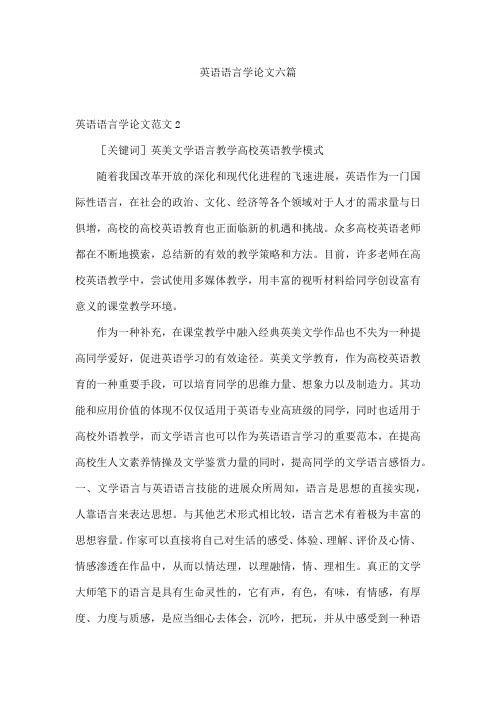
英语语言学论文六篇英语语言学论文范文2[关键词]英美文学语言教学高校英语教学模式随着我国改革开放的深化和现代化进程的飞速进展,英语作为一门国际性语言,在社会的政治、文化、经济等各个领域对于人才的需求量与日俱增,高校的高校英语教育也正面临新的机遇和挑战。
众多高校英语老师都在不断地摸索,总结新的有效的教学策略和方法。
目前,许多老师在高校英语教学中,尝试使用多媒体教学,用丰富的视听材料给同学创设富有意义的课堂教学环境。
作为一种补充,在课堂教学中融入经典英美文学作品也不失为一种提高同学爱好,促进英语学习的有效途径。
英美文学教育,作为高校英语教育的一种重要手段,可以培育同学的思维力量、想象力以及制造力。
其功能和应用价值的体现不仅仅适用于英语专业高班级的同学,同时也适用于高校外语教学,而文学语言也可以作为英语语言学习的重要范本,在提高高校生人文素养情操及文学鉴赏力量的同时,提高同学的文学语言感悟力。
一、文学语言与英语语言技能的进展众所周知,语言是思想的直接实现,人靠语言来表达思想。
与其他艺术形式相比较,语言艺术有着极为丰富的思想容量。
作家可以直接将自己对生活的感受、体验、理解、评价及心情、情感渗透在作品中,从而以情达理,以理融情,情、理相生。
真正的文学大师笔下的语言是具有生命灵性的,它有声,有色,有味,有情感,有厚度、力度与质感,是应当细心去体会,沉吟,把玩,并从中感受到一种语言的趣味性。
因此语言的背后是人的心灵世界。
对文学语言美的敏感与驾驭力量,是提高人的精神境界,使人变得更加美妙的不行或缺的方面。
文学阅读的魅力与意义也就在于此。
目前的高校英语教学,仍旧停留在传统的单纯课文教学,语言点讲解等层面上,课本内容相对陈旧,老师的教学手段也并无创新之处。
其弊端是忽视英语的基本功能即表达功能,也忽视了同学在教学活动中的主体作用,另外还忽视了对同学英语学习爱好的培育,将生硬的课本内容强行“灌输”;至同学脑海中,使整个课堂教学环节缺乏生气,长此以往,高校英语教学将陷入僵局。
关于英语语言学论文免费参考例文
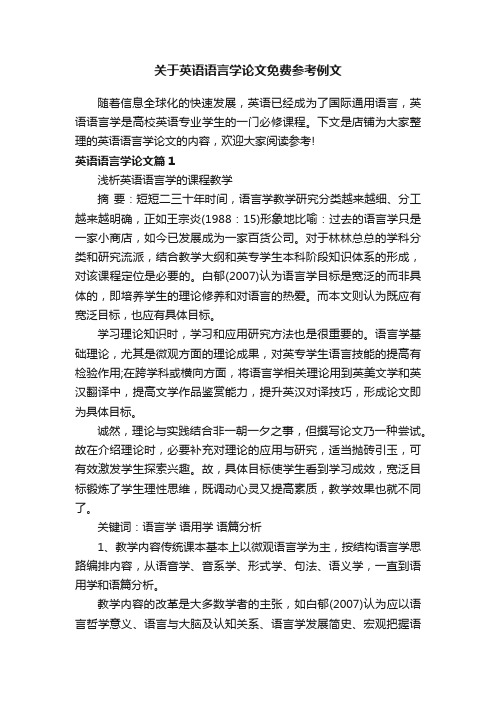
关于英语语言学论文免费参考例文随着信息全球化的快速发展,英语已经成为了国际通用语言,英语语言学是高校英语专业学生的一门必修课程。
下文是店铺为大家整理的英语语言学论文的内容,欢迎大家阅读参考!英语语言学论文篇1浅析英语语言学的课程教学摘要:短短二三十年时间,语言学教学研究分类越来越细、分工越来越明确,正如王宗炎(1988:15)形象地比喻:过去的语言学只是一家小商店,如今已发展成为一家百货公司。
对于林林总总的学科分类和研究流派,结合教学大纲和英专学生本科阶段知识体系的形成,对该课程定位是必要的。
白郁(2007)认为语言学目标是宽泛的而非具体的,即培养学生的理论修养和对语言的热爱。
而本文则认为既应有宽泛目标,也应有具体目标。
学习理论知识时,学习和应用研究方法也是很重要的。
语言学基础理论,尤其是微观方面的理论成果,对英专学生语言技能的提高有检验作用;在跨学科或横向方面,将语言学相关理论用到英美文学和英汉翻译中,提高文学作品鉴赏能力,提升英汉对译技巧,形成论文即为具体目标。
诚然,理论与实践结合非一朝一夕之事,但撰写论文乃一种尝试。
故在介绍理论时,必要补充对理论的应用与研究,适当抛砖引玉,可有效激发学生探索兴趣。
故,具体目标使学生看到学习成效,宽泛目标锻炼了学生理性思维,既调动心灵又提高素质,教学效果也就不同了。
关键词:语言学语用学语篇分析1、教学内容传统课本基本上以微观语言学为主,按结构语言学思路编排内容,从语音学、音系学、形式学、句法、语义学,一直到语用学和语篇分析。
教学内容的改革是大多数学者的主张,如白郁(2007)认为应以语言哲学意义、语言与大脑及认知关系、语言学发展简史、宏观把握语言学真正意义等四方面为重。
还有学者认为增加课外阅读材料以改进教学内容,如王扬(2004)和吴格奇(2005)主张选用有助于学生理解基本理论、概念的材料、辅之以拓宽视野的补充材料。
还有以宏观还是微观语言学内容作为教学重点的争论:“微观”派认为语言内部分支是语言学的基础内容,课时分配比重要大;“宏观”派认为基础部分简单,学生可自学,重点应是宏观介绍;“中间”派是既注重基础又考虑涉猎面。
英语专业语言学论文
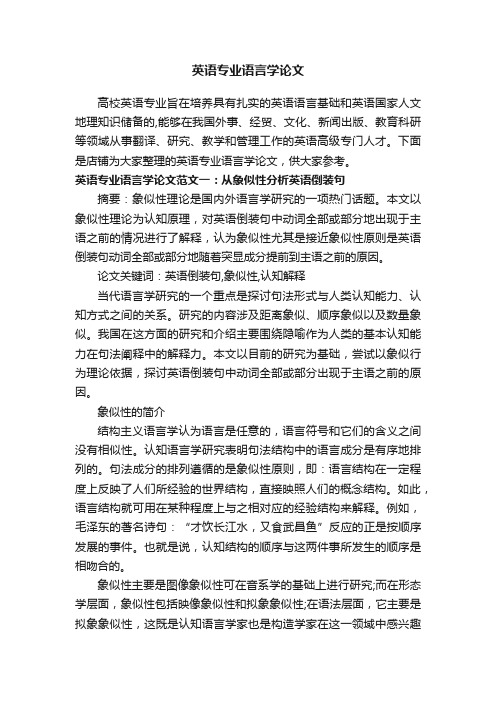
英语专业语言学论文高校英语专业旨在培养具有扎实的英语语言基础和英语国家人文地理知识储备的,能够在我国外事、经贸、文化、新闻出版、教育科研等领域从事翻译、研究、教学和管理工作的英语高级专门人才。
下面是店铺为大家整理的英语专业语言学论文,供大家参考。
英语专业语言学论文范文一:从象似性分析英语倒装句摘要:象似性理论是国内外语言学研究的一项热门话题。
本文以象似性理论为认知原理,对英语倒装句中动词全部或部分地出现于主语之前的情况进行了解释,认为象似性尤其是接近象似性原则是英语倒装句动词全部或部分地随着突显成分提前到主语之前的原因。
论文关键词:英语倒装句,象似性,认知解释当代语言学研究的一个重点是探讨句法形式与人类认知能力、认知方式之间的关系。
研究的内容涉及距离象似、顺序象似以及数量象似。
我国在这方面的研究和介绍主要围绕隐喻作为人类的基本认知能力在句法阐释中的解释力。
本文以目前的研究为基础,尝试以象似行为理论依据,探讨英语倒装句中动词全部或部分出现于主语之前的原因。
象似性的简介结构主义语言学认为语言是任意的,语言符号和它们的含义之间没有相似性。
认知语言学研究表明句法结构中的语言成分是有序地排列的。
句法成分的排列遵循的是象似性原则,即:语言结构在一定程度上反映了人们所经验的世界结构,直接映照人们的概念结构。
如此,语言结构就可用在某种程度上与之相对应的经验结构来解释。
例如,毛泽东的著名诗句:“才饮长江水,又食武昌鱼”反应的正是按顺序发展的事件。
也就是说,认知结构的顺序与这两件事所发生的顺序是相吻合的。
象似性主要是图像象似性可在音系学的基础上进行研究;而在形态学层面,象似性包括映像象似性和拟象象似性;在语法层面,它主要是拟象象似性,这既是认知语言学家也是构造学家在这一领域中感兴趣的主题。
主要的句法象似性包括顺序象似性,接近象似性和数量象似性。
3.倒装句中象似性分析倒装句一直是语法学家研究的课题。
为什么实义动词或助动词(情态动词)要随着被突显部分移到主语之前呢?象似性尤其是接近象似性可以解答这一问题。
语言学导论英语作文
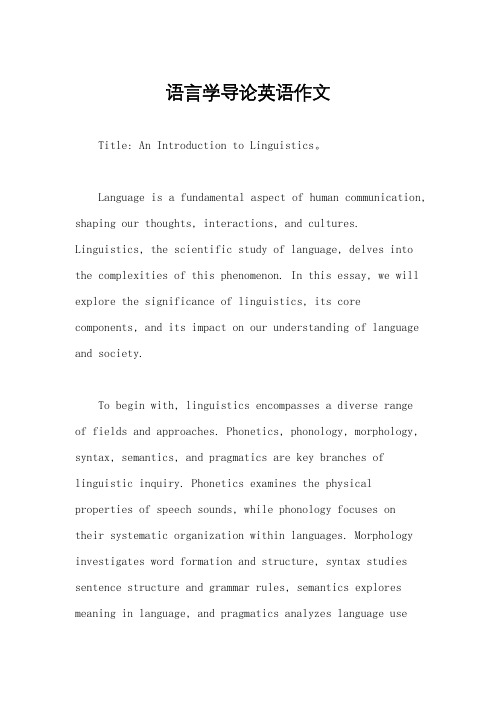
语言学导论英语作文Title: An Introduction to Linguistics。
Language is a fundamental aspect of human communication, shaping our thoughts, interactions, and cultures. Linguistics, the scientific study of language, delves into the complexities of this phenomenon. In this essay, we will explore the significance of linguistics, its core components, and its impact on our understanding of language and society.To begin with, linguistics encompasses a diverse rangeof fields and approaches. Phonetics, phonology, morphology, syntax, semantics, and pragmatics are key branches of linguistic inquiry. Phonetics examines the physical properties of speech sounds, while phonology focuses ontheir systematic organization within languages. Morphology investigates word formation and structure, syntax studies sentence structure and grammar rules, semantics explores meaning in language, and pragmatics analyzes language usein context.One of the central aims of linguistics is to understand how language is acquired, used, and processed byindividuals and communities. Psycholinguistics studies the cognitive processes involved in language comprehension and production. Sociolinguistics examines how social factors such as region, class, and ethnicity influence language variation and use. Historical linguistics traces language change over time, revealing connections between languages through language families and linguistic evolution.Furthermore, linguistics plays a crucial role in broader societal contexts. Applied linguistics applies linguistic theories to real-world issues, such as language teaching, translation, and language policy. Computational linguistics develops algorithms and models for natural language processing and artificial intelligence applications. Forensic linguistics aids legalinvestigations by analyzing language evidence, such as authorship attribution and deception detection.The study of linguistics also deepens our understanding of human cognition and cultural diversity. Noam Chomsky's theory of universal grammar suggests that all human languages share underlying principles, highlighting the innate aspects of language acquisition. The Sapir-Whorf hypothesis proposes that language shapes thought, influencing how speakers perceive and interpret the world around them.Moreover, linguistics sheds light on the intricate interplay between language and identity. Language serves as a vehicle for cultural expression and collective memory, reflecting societal norms and values. Endangered languages, in particular, highlight the importance of linguistic diversity and preservation efforts to safeguard linguistic heritage and knowledge.In conclusion, linguistics is a multifaceted discipline that explores the nature, structure, and function of language. From its theoretical foundations to its practical applications, linguistics illuminates the complexities of human communication and enriches our understanding oflanguage diversity and cultural dynamics. By studying linguistics, we gain insights into the intricate workings of language and its profound impact on human cognition, society, and identity.This introduction to linguistics underscores its significance as a cornerstone of human knowledge and underscores the relevance of linguistic inquiry in our increasingly interconnected world.。
《英语言文学》毕业论文范文

《英语言文学》毕业论文范文英语言文学毕业论文范文引言英语言文学是一门研究英语语言和英美文学的学科。
毕业论文是英语言文学专业学生完成学业的重要组成部分。
本文将为大家呈现一篇关于英语言文学的毕业论文范文,以供参考。
研究背景英语言文学作为一门学科,对于了解英语语言和文学的发展历程及影响具有重要意义。
通过研究英语言文学,我们可以深入探讨英语的演变、文学作品的创作与解读等方面的内容。
研究目的本论文的研究目的是分析英语言文学在不同历史时期的发展演变,并探讨其对当代英语研究及文化交流的影响。
研究方法本论文采用文献资料分析和比较研究的方法,收集和整理相关的英美文学作品和相关研究成果,以探讨英语言文学的发展历程和影响。
论文结构本论文主要分为以下几个部分:1. 引言:介绍英语言文学研究的背景和研究目的。
2. 文献综述:总结和分析已有的关于英语言文学的研究成果。
3. 研究方法:介绍本文所采用的研究方法和数据来源。
4. 结果与讨论:展示研究结果,并对其进行深入分析和讨论。
5. 结论:总结本论文的主要研究成果,并提出未来研究的展望。
期望成果通过对英语言文学的研究,我们可以更好地了解英语的演变历程和文学作品的内涵,同时也可以为当代英语研究和文化交流提供一定的借鉴和启示。
希望本论文的研究成果能够为相关领域的学术研究和教学实践提供一定的参考价值。
结论通过本篇毕业论文范文的介绍,我们可以了解到英语言文学的研究内容和方法。
对于英语言文学专业的学生来说,完成一篇高质量的毕业论文是提高自己学术水平和专业能力的重要机会。
希望对大家在撰写英语言文学毕业论文时能够有所帮助。
英语语言学毕业论文2篇

英语语言学毕业论文标题:英语语言学研究——语音学与语法学的关系第一篇:语音学在英语语法学中的应用引言英语语法学作为语言学的一个重要分支,研究语言的结构和形式,其中语音学是重要的一部分。
本篇论文将探讨语音学与英语语法学的关系,从语音学在英语语法学中的应用角度进行分析与讨论。
一、语音学在英语语法学中的基础作用1. 音素的定义与分类2. 音节的组成与结构3. 重音与音调二、语音学在英语语法学中的具体应用1. 语音规律对语法结构的影响(1) 语音变化与语法形式(2) 语音对语法意义的影响2. 语音与句法的关系(1) 语音形式与句法结构的对应关系(2) 语音连读对句法关系的影响结论语音学在英语语法学中扮演着重要的角色。
通过对语音学在英语语法学中的基础作用和具体应用的分析,可以看出语音学是研究英语语法学不可或缺的一部分,对于准确理解和使用英语语法具有重要意义。
第二篇:语法学在英语语音学中的应用引言英语语音学作为语言学的一个重要分支,研究语音的产生、传播和接收,其中语法学是重要的一部分。
本篇论文将探讨语法学与英语语音学的关系,从语法学在英语语音学中的应用角度进行分析与讨论。
一、语法学在英语语音学中的基础作用1. 语音规则与语法关系2. 重读与语法意义关联3. 语法结构对语音形式的影响二、语法学在英语语音学中的具体应用1. 语法规则对语音的影响(1) 语法变化与语音形式(2) 语法对语音意义的影响2. 语法与韵律的关系(1) 语法结构对韵律的影响(2) 语法形式与语音调的关联结论语法学在英语语音学中发挥着重要的作用。
通过对语法学在英语语音学中的基础作用和具体应用的分析,可以看出语法学是研究英语语音学不可或缺的一部分,对于深入理解和研究英语语音规律具有重要意义。
参考文献:1. Yule, G. (2010). The Study of Language (4th ed.). Cambridge University Press.2. Fromkin, V., Rodman, R., & Hyams, N. (2017). An Introduction to Language (11th ed.). Nelson Education.3. Ladefoged, P., & Johnson, K. (2010). A Course in Phonetics (6th ed.). Wadsworth Publishing.。
英语语言学方面论文

英语语言学方面论文英语是现代世界中最为广泛使用的语言之一。
随着全球化的进程加速,英语已经成为了国际交流和商业往来中的主要语言之一。
在这些背景下,英语语言学的研究显得越发重要。
本文旨在探索英语语言学的相关研究,包括其发展历程、研究内容以及未来研究方向。
发展历程英语语言学作为一门独立的学科出现于20世纪初。
在这之前,语言学多属于文学学科的一个分支,因此研究范畴较为狭窄。
20世纪初,西方国家开始出现语言学变革的思想,英语语言学也因此成为独立学科。
在本阶段中,学者们主要关注英语的语音、语法和词汇等方面的研究,同时也有一些学者开始研究非标准化的英语方言,如美国南部黑人英语等。
到了20世纪50年代,英语语言学进入了新的阶段,研究范围逐渐扩大到了应用领域,如如英语教学和翻译等。
随着科技的不断发展,英语语言学也得到了越来越多的应用。
例如由此出现了自然语言处理技术,这种技术旨在让计算机识别人类语言产生的信号,以完成人与计算机之间的交流。
研究内容英语语言学涉及的研究领域非常广泛。
以下是其中一些方面:1. 语音学语音学研究语音的产生、使用和描述。
这个领域的研究可以解释语言中不同音素之间细微差别的生理和物理机制。
语音学从英语学习的角度探讨点便是如何发音,音素之间的变异以及其他与英语发音有关的问题。
2. 语法学语法学是英语语言学的基础,用于研究言语产生的规则和机制,以及词汇和结构在句子中的使用。
语法学可以深入研究单词的结构以及其在句子中的功能,研究文化及其逻辑结构的规则,以及句子结构的研究等等。
3. 语义学语义学是研究语言意义的学科领域。
这个领域的研究可以解释和分析个别语言单词的意义和该单词在上下文中的实际含义。
语义学深入到许多不同的领域,包括语言哲学、语言学和社会学。
4. 语用学语用学是研究语言在特定上下文中实际使用的学科领域。
语用学从语言学和社会学的角度来研究语言使用,研究语言在上下文中不同的意义,以及语言与文化、行为以及认知之间的联系。
关于英语语言学论文范文参考
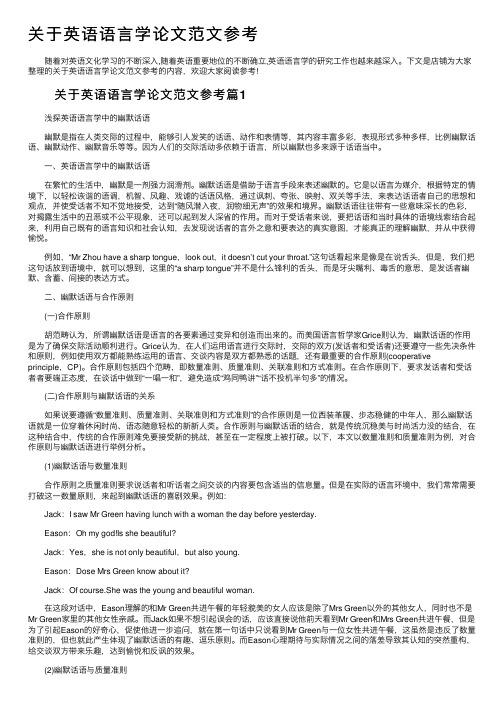
关于英语语⾔学论⽂范⽂参考 随着对英语⽂化学习的不断深⼊,随着英语重要地位的不断确⽴,英语语⾔学的研究⼯作也越来越深⼊。
下⽂是店铺为⼤家整理的关于英语语⾔学论⽂范⽂参考的内容,欢迎⼤家阅读参考! 关于英语语⾔学论⽂范⽂参考篇1 浅探英语语⾔学中的幽默话语 幽默是指在⼈类交际的过程中,能够引⼈发笑的话语、动作和表情等,其内容丰富多彩,表现形式多种多样,⽐例幽默话语、幽默动作、幽默⾳乐等等。
因为⼈们的交际活动多依赖于语⾔,所以幽默也多来源于话语当中。
⼀、英语语⾔学中的幽默话语 在繁忙的⽣活中,幽默是⼀剂强⼒润滑剂。
幽默话语是借助于语⾔⼿段来表述幽默的。
它是以语⾔为媒介,根据特定的情境下,以轻松诙谐的语调,机智、风趣、戏谑的话语风格,通过讽刺、夸张、映射、双关等⼿法,来表达话语者⾃⼰的思想和观点,并使受话者不知不觉地接受,达到“随风潜⼊夜,润物细⽆声”的效果和境界。
幽默话语往往带有⼀些意味深长的⾊彩,对揭露⽣活中的丑恶或不公平现象,还可以起到发⼈深省的作⽤。
⽽对于受话者来说,要把话语和当时具体的语境线索结合起来,利⽤⾃⼰既有的语⾔知识和社会认知,去发现说话者的⾔外之意和要表达的真实意图,才能真正的理解幽默,并从中获得愉悦。
例如,“Mr Zhou have a sharp tongue,look out,it doesn’t cut your throat.”这句话看起来是像是在说⾆头,但是,我们把这句话放到语境中,就可以想到,这⾥的“a sharp tongue”并不是什么锋利的⾆头,⽽是⽛尖嘴利、毒⾆的意思,是发话者幽默、含蓄、间接的表达⽅式。
⼆、幽默话语与合作原则 (⼀)合作原则 胡范畴认为,所谓幽默话语是语⾔的各要素通过变异和创造⽽出来的。
⽽美国语⾔哲学家Grice则认为,幽默话语的作⽤是为了确保交际活动顺利进⾏。
Grice认为,在⼈们运⽤语⾔进⾏交际时,交际的双⽅(发话者和受话者)还要遵守⼀些先决条件和原则,例如使⽤双⽅都能熟练运⽤的语⾔、交谈内容是双⽅都熟悉的话题,还有最重要的合作原则(cooperative principle,CP)。
关于英语语言学论文

关于英语语言学论文英语语言学作为高校英语专业必修课程之一,对于培养学生的英语语言能力起着重要的作用。
下文是店铺为大家整理的关于英语语言学论文的范文,欢迎大家阅读参考!关于英语语言学论文篇1浅谈英语语言学教学培养语言意识,发展理性思维,有助于拓宽学生的思路和视野,全面提高学生的素质。
其课程的重要性不言而喻。
然而,该课程在实际教学过程中却遭遇了尴尬:教者乏味、学者无趣。
因此,从学生的视角而言,改变语言学的教学现状,增强语言学的教学效果,就必须增强英语语言学教学的趣味性和吸引力,将趣味性和知识性融为一体,才能激发学生学习的热情,让更多的人从中受益。
一、趣味性研究的价值英语语言学教学依旧停留在语言理论知识的传授,忽视理论知识实际运用能力的培养,学生体会不到该课程学习的乐趣和用处,最终影响了教学效果首先要培养学生的语言学学习兴趣,使学生觉得语言学课程有趣、有用,他们才会有学习的动力和激情。
只有增加学生自主学习的时间和空间,拓宽学生知识面,增强学生的学习兴趣,完善学生的知识结构,促进学生个性发展。
可见,兴趣对于学习的意义。
没有兴趣就没有学习,这正是当前语言学这类理论知识课程教学所要面对和解决的问题。
二、趣味性教学缺失的原因1.学生的困惑与茫然。
立足于语言学教学枯燥、缺乏趣味性的现状,对学生而言,其理解能力有限,对于英语语言学这样一门难度较大、理论性较强的专业知识课程普遍存在畏难情绪和抵触情绪,挫伤了学生对趣味性活动开展的兴趣。
与此同时,学生对语言学的学习目的茫然,大部分学生忙于死记硬背单词、术语和定义,投入了大量的时间与精力,但最终也没有明白语言学学习目的所在,从而扼杀了趣味性教学的实际价值。
2.教师的自我中心主义。
语言学教学无疑成了教师死板地给对学生灌输语言学术语的过程,学生丧失了发现问题、独立思考、平等交流的机会,其能力的培养自然无从谈起。
理论知识是研究人员和学者研究的成果和理论,包括专业知识、教育理论知识、关于人类发展的知识、指导课堂组织的理论知识、教学法知识、评价理论知识、社会文化知识,等等。
英语语言学方面论文

英语语言学方面论文英语作为一种国际化的语言,在信息化、全球化日益发展的今天,其作用越来越重要。
下文是店铺为大家整理的关于英语语言学方面论文的范文,欢迎大家阅读参考!英语语言学方面论文篇1浅探新时代和谐英语语言学课堂的构建【摘要】探索一条有效的语言学教学途径一直是大学英语教育者关注的问题,本文从和谐的角度探讨英语语言学和谐课堂的构建。
分析什么是和谐课堂,进而利用和谐教学、和谐环境等理论方法指导语言学教学的实际,达到构建英语语言学和谐课堂的效果。
【关键词】英语语言学语言学课堂和谐课堂的构建良好的和谐的课堂气氛能激活学生的脑细胞,激发他们的学习兴趣,开发他们的思维潜能,更好地促进他们接受新知识,掌握新技能。
如何创造和谐的课堂气氛,有效地促进教学,是每个英语教学者都必然关注的问题。
美国心理学家罗杰斯认为:“成功的教学依赖于一种真诚的理解和信任的师生关系,依赖于一种和谐安全的课堂气氛。
”由此可见,一个成功的课堂与和谐安全的课堂气氛息息相关。
英语专业的学生在掌握了听说读写这些基本技能的基础上,需要进一步比较全面、比较系统地了解现代语言学这一领域的研究成果,以及一些最主要、最有影响的语言理论和原则,从而加深对人类语言这一人类社会普遍现象的理性认识,并具备一定的运用语言学理论解释语言现象、解决具体语言问题的能力,提高自身的语言修养和学习语言的能力。
一、英语语言学课程的特点课程的教学任务和目的是向学生讲授英语语言的属性、功能、起源和内部层次,掌握英语语言学基本特征和主要分支的基本概念,了解语言在时空中的变异及其与社会、文化、语境、思维等外部因素的关系,同时了解部分主要语言学流派。
英语语言学的教学内容宽泛,不易深细,主要包括英语语言和英语语言学领域中各分支的基础理论,如语音学、音系学、形态学、句法学、语义学、语用学等基本内容,也包括了语言的变异及其与外部因素的关系。
二、英语语言学的授课对象英语语言学教程的授课对象是学习英语的高等院校学生,因此在讲解过程中大部分采用了英语。
英语语言学方面的论文
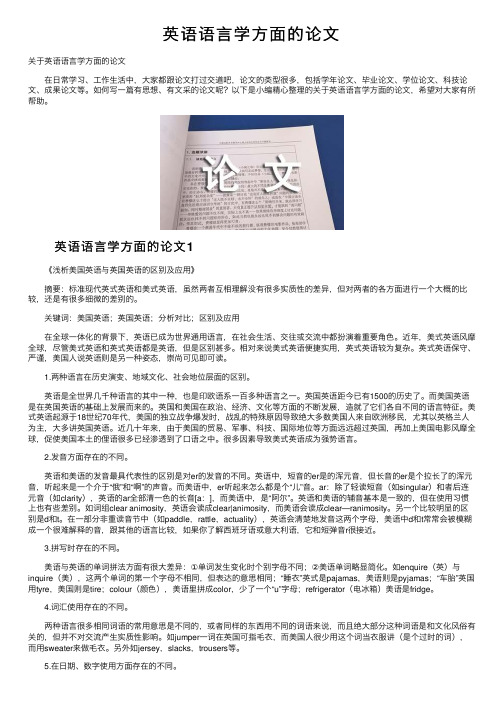
英语语⾔学⽅⾯的论⽂关于英语语⾔学⽅⾯的论⽂ 在⽇常学习、⼯作⽣活中,⼤家都跟论⽂打过交道吧,论⽂的类型很多,包括学年论⽂、毕业论⽂、学位论⽂、科技论⽂、成果论⽂等。
如何写⼀篇有思想、有⽂采的论⽂呢?以下是⼩编精⼼整理的关于英语语⾔学⽅⾯的论⽂,希望对⼤家有所帮助。
英语语⾔学⽅⾯的论⽂1 《浅析美国英语与英国英语的区别及应⽤》 摘要:标准现代英式英语和美式英语,虽然两者互相理解没有很多实质性的差异,但对两者的各⽅⾯进⾏⼀个⼤概的⽐较,还是有很多细微的差别的。
关键词:美国英语;英国英语;分析对⽐;区别及应⽤ 在全球⼀体化的背景下,英语已成为世界通⽤语⾔,在社会⽣活、交往或交流中都扮演着重要⾓⾊。
近年,美式英语风靡全球,尽管美式英语和英式英语都是英语,但是区别甚多。
相对来说美式英语便捷实⽤,英式英语较为复杂。
英式英语保守、严谨,美国⼈说英语则是另⼀种姿态,崇尚可见即可读。
1.两种语⾔在历史演变、地域⽂化、社会地位层⾯的区别。
英语是全世界⼏千种语⾔的其中⼀种,也是印欧语系⼀百多种语⾔之⼀。
英国英语距今已有1500的历史了。
⽽美国英语是在英国英语的基础上发展⽽来的。
英国和美国在政治、经济、⽂化等⽅⾯的不断发展,造就了它们各⾃不同的语⾔特征。
美式英语起源于18世纪70年代,美国的独⽴战争爆发时,战乱的特殊原因导致绝⼤多数美国⼈来⾃欧洲移民,尤其以英格兰⼈为主,⼤多讲英国英语。
近⼏⼗年来,由于美国的贸易、军事、科技、国际地位等⽅⾯远远超过英国,再加上美国电影风靡全球,促使美国本⼟的俚语很多已经渗透到了⼝语之中。
很多因素导致美式英语成为强势语⾔。
2.发⾳⽅⾯存在的不同。
英语和美语的发⾳最具代表性的区别是对er的发⾳的不同。
英语中,短⾳的er是的浑元⾳,但长⾳的er是个拉长了的浑元⾳,听起来是⼀个介于“俄”和“啊”的声⾳。
⽽美语中,er听起来怎么都是个“⼉”⾳。
ar:除了轻读短⾳(如singular)和者后连元⾳(如clarity),英语的ar全部清⼀⾊的长⾳[a:],⽽美语中,是“阿尔”。
英语语言学方面论文(2)

英语语言学方面论文(2)英语语言学方面论文篇3浅析语言学习中的英汉对比论文关键词:语言学习母语正迁移母语负迁移论文摘要:在二语学习中,学习者的母语会对二语习得产生独特的影响,因此在语言的学习中,要针对其特点,采取对应的方法。
英汉对比教学和学习能有效地降低语言学习中的母语负迁移,更好地发挥母语的正迁移作用。
1 引言二语习得过程中,母语会不可避免地对学习者产生一定的影响。
母语和二语之间的相似之处会促进语言的学习,此现象为母语正迁移;而不同之处将阻碍语言的学习,此现象被称之为母语负迁移。
学习者要有意识地发挥其有利的影响,降低其不利影响。
因此英汉对比研究对二语习得是非常必要的。
2 英汉对比学习的理论依据在二语习得过程中,母语会产生迁移作用,这是被语言学家所证实的事实。
Odlin(2001)这样定义语言迁移,它是一种跨语言的影响,这种影响是由学习者先前习得的语言和目标语之间的相似和差异引起。
语言之间的相似之处有助于二语的习得,这种影响称之为正迁移,而语言之间的差异会阻碍二语的习得,称之为负迁移。
在二语习得过程中,先前习得的语言,一般是母语,已经有了完善的知识结构和牢固的基础,这一特点给二语习得带来的既有积极的作用,同时也会产生负面的影响。
如何发挥其积极作用,减少负面影响是语言学习者有效提高语言学习效率的重要方面。
因此英汉不同之处的对比就变得尤为重要。
3 英汉对比的方面3.1 本体对比3.1.1 大小写方面在汉语中,我们不用考虑汉字的大小写,因为汉字不存在大小写的区别。
而英语的字母则不同,有大小写之分。
以汉语为母语的学习者,由于大小写概念不强,母语的不区分大小写的印象又很深,因此很容易在此方面出错。
英语中一个句子的首字母是必须要大写的,还有一些专有名词,如地名,人名,书名等。
3.1.2 标点符号英汉语在标点上有些是不同的,如句号的写法。
英语是一个实心的圆点,而汉语是一个圆圈。
汉语中有书名号,英语中用引号,或斜体不加标点。
英语语言学论文

英语语言学概论论文论文题目:An Analysis of Euphemism in English From the Politeness Principle of PragmaticsAbstractEuphemism, cosmetic words, is not only a lingual phenomenon, but also a cultural and social phenomenon.It is like a mirror, reflecting the values, aesthetic conceptions and moral concepts in some extent.Euphemism plays an important part in social communication.It is like lube that avoids hurting the other party’s feeling.It oils the human relationship in communication and helps to save face of communicators.If people make full use of euphemism, it can accelerate and facilitate human communication.This paper elaborates on the features and social functions of euphemism.And it focuses on the relationships between its polite functions and Politeness Principle.This thesis is composed of six parts with Chapter Four and Five as its core: The first chapter focuses on the origin and definitions of euphemism.The second chapter discusses the features of euphemism in many ways.The third chapter talks about the social functions of euphemism from the angle of pragmatics.The fourth chapter forms the basis of the whole research by connecting euphemism with politeness and face-saving theory.The fifth chapter centers on euphemism and Politeness Principle.The last chapter concludes the whole thesis.Appropriate use of English euphemism can contribute a lot to successful message exchange.Key Words: euphemism; social functions; Politeness Principle; face1.IntroductionThere is a humor: Once a Paris tourist resided in UK.A landlady told him sadly that, “My husband has just passed to the other side.” The guest looked from the fence of the garden but saw no one, feeling confused.The landlady explained: “I mean he’s kicked the bucket.” The guest comforted her that: “I hope his foot will be better soon.”The landlady felt unintelligibly and said: “No, he wasn’t here, he snuffed it… you know.” The guest wondered and said: “But you’ve got electricity here.”The reasons why the guest didn’t answer properly are that he didn’t realize that the landlady used euphemism, nor did he understand the “conversational implicature” of euphemism.What the landlady wanted to say is that her husband died.The word euphemism comes from the Greek word “euphemos”, meaning "auspicious/good/fortunate speech" which in turn is derived from the Greek root--- words eu, "good/well" + pheme, "speech/speaking".The eupheme was originally a word or phrase used in place of a religious word or phrase that should not be spoken aloud (Such as taboo).The primary examples of taboo words requiring the use of a euphemism are the unspeakable names for a deity, such as Persephone, Hecate, Nemesis or Yahweh.By speaking only words favorable to the gods or spirits, the speaker attempted to produce good fortune by remaining in good favor with them.“Euphemism is defined in the New Edition of the Oxford Concise Dictionary (1976) as‘Substitution of mild or vague or roundabout expression for harsh or direct one; expression thus substituted.’ IN Webster’s New Collegiate Dictionary (1973) the definition reads, ‘Substitution of an agreeable or inoffensiveexpression for one that may offend or suggest something unpleasant.’”Euphemism is an important rhetorical means in English.Itplays an important role in people’s daily communication.Itis not only a culturalphenomenon, but also a social phenomenon.It just likes amirror, which reflects some social and psychological phenomena.2.Features of euphemism 2.1 Indirect and implicitThe most important character of euphemism is indirect and implicit.Euphemism always gives people hints in a roundaboutway.We can infer the deeper meaning and intention from the context.For example, when someone is ill, we always say heis under the weather.If someone is mad, we say he is soft inmind.2.2 UniversalityUniversality is something that is well-known and acceptedby all of the people.Though euphemism is indirect and itdoesn’t come straight to the point, people can easily inferits deeper implication.Some taboos connected with sex, death,or body functions are replaced by euphemisms.And the publichas accepted this kind of use.For example, when we refer to death, we seldom say “die”.We use the expression “pass away”.2.3 The feature of timesThe changes of language depend on the need and changes ofthe society.And euphemism undergoes a process ofmetabolism.It bears a marked brand of times.For example,“‘She is pregnant’ has many different euphemisticexpressions in different eras.(1) She has canceled all her social engagements.(1856)(2) She is in an interesting condition.(1880)(3) She is in a delicate condition.(1895)(4) She is knitting little bootees.(1910)(5) She is in a family way.(1920)(6) She is expecting.(1935)(7) She is pregnant.(1956)”But after 1960s, euphemisms of pregnant develop slowly because in modern times, people are not so implicit.They always mention things directly.And now, the phenomenon of pregnant is a cheerful thing.People will not be shy when mentioning it.3.Pragmatic functions of euphemism3.1 Taboo function“Taboo is the main psychological basis of the emergence of euphemism.Euphemism is the avoidance of the unpleasant, inelegant things.A famous sociolinguist Mr.Chen Yuan once said: ‘Generally speaking, the coming into being of euphemism all begins from taboo.’ From the origin of euphemism, we can see that taboo is the first function of euphemism.Euphemism has been using for a long time, and it is closely related to taboo.In fact, euphemism dates back to the language taboo in the early period of human civilization.When people try to avoid and give up taboo words, they have to find another word to replace this vacancy at the same time.Hence, people created euphemism.”There are some taboo things, such as birth, death, funeral, sex, nakedness, defecation, and urinate.If they are expresseddirectly, they are called taboo words and the feelings they give us are vulgar, crude and harsh, whereas if they are expressed indirectly, they are called euphemism, and the impressions they made on us are elegant, implicit and polite.The evading function of euphemism also works today.Some taboo notions cannot be easily removed from people’s mind.Though science and technology are highly developed today, the word “death” is the taboo words to all nations.Thus there are a lot of euphemisms related with it.“Such as pass away, answer the final call, be asleep in Jesus, be safe in the arms of Jesus, be at rest, be called to God, be home and free, be in Abraham’s bosom, cross the River Jordan, final sleep, go home, go to meet one’s maker, go to one’s own place, join one’s ancestors, join the great majority, return to dust, with God, be no longer with us, pay the debt of nature, tick the bucket, etc.”“Among those, ‘one-way-ticket’ is the synonym of ‘die’.It reflects the speaker’s experience of life.Life is just like travel.People set out to travel, but when they arrive to the termination, they cannot go back.In the past, people often used graveyard to express the place where the dead sleep peacefully.But the associations it gives us are horrified and gloomy.So now, people use funeral home and memorial park to replace them.In such a way, it comforts people.”3.2 Polite functionPolite function of euphemism is to avoid inelegant things and make people feel pleasant.As Joanna Channell put in her book Vague Language “Vagueness is used as one way of adhering to the politeness rules for a particular culture, and of notthreatening face.” It means that in real life, when peoplemeet with some unpleasant things or behaviors, they usually choose some vague expressions to avoid making bold or hurting other’s feeling----to use euphemism.It is harsh to say someone is deaf, so people use“auditory-impaired” to replace it.They sound moregracefully.“When English-speakers refer to the appearance,they don’t use the word ‘ugly’ or ‘awful’, which has strong derogatory sense.Instead, they use the word ‘plain-looking’or ‘not pretty’.” Westerners are sensitive to age.In their opinion, “old” equals to “useless” in some extent.In ordernot to hurt the feeling and self-esteem of the old, “old men”are replaced by “senior citizens” or “seasoned men”.Forthe word “senior” has many meanings.Except “older”, italso means higher in rank or authority.And the word“seasoned” means experienced.3.3 Tactical functionIf a same meaning is expressed in many different ways,their effects are entirely different.This is what we calledthe art of speaking.If we apply this strategy to our dailylife, our life will be more colorful.For example, on the plane,there are some bags that can be used by the passengers to shoothis cookies.People don’t print the words “vomit bag” onthe surface of the bag.Instead, they use the words “for motion discomfort”. And the result proved that the vomit phenomenonhas reduced.Because compared with the former words, the word“for motion discomfort” prevents the passengers fromvomiting when in a state of airsickness.This is the tactical function of euphemism.By contrary, if we use euphemism inappropriately, theresult would be worse.Try to compare the following two statements:I am an old cripple, drawing an old-age pension, working hard to raise vast quantities of vegetables on an allotment and well aware that, one of these days, I shall die. If, however, I listen to the voice of officialdom, it turns out that I am a disadvantaged senior citizen, registered as disabled, drawing a retirement pension, renting a leisure garden and, presumably, immortal because I shall never die--- I shall merely pass away.We can see that in the first statement, the author talks directly about his life status.The second statement is that the government officials make a survey of the hardship of citizens.They try to cover the facts by using euphemisms.4.Euphemism and politeness4.1 Euphemism and interpersonal communicationEuphemism has been widely used in the real human communication.It can be regarded as a kind of polite terms .In primitive and traditional society, taboo and euphemism are the two sides of a coin.They are used for social control and religious control.And in modern English, there are a number of words connected with holy, sex, body organ and body function.So when people’s topic refers to those, they have to find euphemisms to replace them.They often use some vague language to avoid mentioning them directly.4.2 Politeness and face-threatening theoryThe main function of euphemism is polite function.Thus, the main character of euphemism is polite.Politeness plays an important role in human communication.It oils human relationships.So euphemism accords with politeness willaccelerate human communication.5.Euphemism and Politeness PrincipleFrom the above, we know that euphemism has something to do with politeness.We can associate politeness with Politeness Principle.5.1 Leech’s politeness principle“Generally speaking, most of the euphemisms accord with conversational principle, especially politenessprinciple.Leech’s maxims of the Politeness Principle tend to go in pairs as follows:(1)Tact Maxim :a.Minimize cost to other;b.Maximize benefit to other.Some examples : a、If you keep this diet, you’ll be on the heavy side.(c.f.: If you keep on eating too much, you’ll become very fat.)b、Thank you for your kind hospitality.(c.f.: Thank you for your delicious food.)(2)Approbation Maxim:a.Minimize dispraise of other;b.Maximize praise of other.Some examples: a、He is a senior citizen now.(c.f.: He is an old man now.)b、Cao Yu is a Shakespeare of China.(c.f.: Cao Yu is the best playwright of China.)(3)Modesty Maxim :Minimize praise of self;b.Maximize dispraise of self.Some examples: a、This is a token of my regard for you.(c.f.: This is a present for you.)b、Your praise is the highest honor for me.(c.f.: Thank you for your praise.)Leech ties politeness to the relationship between both parties and the language used.He claims that “static” feature, such as social distance, interact with “dynamic” features, such as the kind of illocutionary demand the speaker is making on the maker, to produce an appropriate degree of politeness.The core of his politeness is to minimize the expression of impolite benefits.5.2 Polite function and Politeness PrinciplePolite function is the basic social function of euphemism.And Politeness Principle shows this function.Euphemism always abides by the Politeness Principle.In such a case, euphemism can make people’s relationship more harmonious.But there are also some exceptions.Euphemisms of military do not accord with Politeness principle most of the time.5.3 Politeness Principle and the cooperative PrincipleThe Politeness Principle shows equal and friendly relationships between people in the society.It demands that in communication, the speaker should cooperate with the hearer.The two parties use euphemisms to replace harsh words because it can meet the psychological needs of face-want.And the language used by the two parties should be appropriate.Generally speaking, the appropriateness of the speech is closely related with euphemism.However, “The Maxim of Relevance” of Grice’s “Cooperative Principle” limits the choice of euphemism.He suggests that in communication, the reply of the hearer should be closely related to the speech of the speaker.In the process of communication, the euphemisms used just now should be connected with the primary language symbols.In such case, it will provide a clue to the hearer so that he can understand the connotation of thespeech.This principle provides a lot of standard conversational implicatures. In a word, the two parties can understand the intention of each other from the context.A: How is John doing with his study at schoolB: He’s a machine.Here, from the literal meaning of B's reply, he seems haven’t answer A’s question.But at least, his answer violates Quality Maxim and Relation Maxim.We know that though B’s answer doesn’t cooperate with A’s question, we can still understand B’s meaning by the deeper implication of his speech.First, we should suppose that this conversation tally with Cooperative Principle.Second, we can guess the implication between machine and study.At last, we can infer that John is hard-working.Thus, if the utterance is not relevant with each other, we can reason.“Unlike presuppositions and entailments, implicatures are inferences that cannot be made from isolated utterances.They are dependent on the context of the utterance and the shared knowledge between the speaker and the hearer.”6.ConclusionEuphemism is an appropriate language form created by people to achieve an ideal communicative effect in the social interactions.“Enrighr D.J.stated that ‘If euphemism doesn’t exist, the movement of the world will stop and it will be filled with hatred.” Nearly no one can live without euphemism.Euphemism is not only a social phenomenon, but also a lingual phenomenon.The formation of euphemism is the result of social factors and psychological factors.From the day of its birth, there are countless ties between euphemism and thesocial culture.Euphemism develops while the society develops.Euphemism is a mirror.We can learn the values and moral concepts of the society.Euphemism that accords with Politeness Principle oils human communication because polite function is the main function of Politeness principle.If we make good use of this language form, it will accelerate and facilitate human communication.People’s interpersonal relations will be more harmonious.We can make full use of euphemism and make our life more colorful.References:1.李国南.辞格与词汇 [M].上海: 上海外语教育出版社,2001.2.胡春梅.论委婉语的构成及功能[J].浙江教育学院学报,2005,1.3.刘纯豹.英语委婉语词典[Z].北京: 商务印书馆,2001.4.吴祥云.委婉语的社会功用[J].昭通师范高等专科学校学报,2004,2.5.Joanna Channell.Vague Language [M].上海:上海外语教育出版社,2000,6.6.李鑫华.英语修辞格详论[M].上海:上海外语教育出版社,2000.7.李树德.冯奇.英语修辞简明教程[M].上海:复旦大学出版社,2003,10.8.Jean Stilwell Peccei.Pragmatics [M].北京:外语教学与研究出版社,2000,8.。
关于英语语言学方面论文发表

关于英语语言学方面论文发表英语语言学是一门英语语言的理论,对英语的发展极为重要。
下文是店铺为大家整理的关于英语语言学方面论文发表的范文,欢迎大家阅读参考!关于英语语言学方面论文发表篇1论英语口语教学中的合作语言学习前言随着教育体制改革的不断深入和素质教育的广泛开展,语言教育界的教育思想在不断更新,广大教师的教育观念也在不断转变。
近年来,语言教学逐渐从以教师为中心转向以学生为中心,从以被动的知识传授为重点转向以学生的主动学习和参与为重点。
在这一转变过程中,人们开始关注学习者协作和沟通的重要性。
在这种情况下,合作语言学习(cooperative language learning)得以产生,继而得到了广泛的关注和应用。
笔者也在英语口语教学(oral English teaching)中尝试了合作语言学习的方法。
在实践中,笔者深感合作语言学习对英语口语教学的促进作用,同时也发现了合作学习中存在的一些问题。
因此,本文将对英语口语教学中的合作学习进行探讨,旨在使广大教师更新传统的教学模式,促进学习者之间的相互合作,从而提高学习者的学习效率,提升教学效果。
英语口语教学现状分析传统的口语教学主要是以教师指导下的个人学习为主。
长久以来,教师在口语教学中一直担当着教练的角色。
学生学什么、怎么学、如何对学生进行评价等往往由教师以一刀切的形式强行规定。
而实际上,口语学习的任务是多元和复杂的,它不仅涉及到基本的语言知识,还涉及到语言思维方式的转变,以及语言交际技巧的灵活运用。
与此同时,学生的口语水平也存在着很大差异,不同学生有不同的学习目标。
在这种情况下,教师单一固化的决策很难满足学生的实际需要,因此,课堂口语教学往往成效甚微。
此外,在口语学习中,教师还一直发挥着模范示例的作用。
教师的语音(pronunciation)、语调(intonation)、语气(tone)、措辞(expression)、语言习惯(language habit)等都是学生模仿和学习的对象,因此,实际的教学中我们经常会看到一个教师的学生在口语使用上有惊人的雷同和类似,而这种千人一律的口语并不是我们口语教学的初衷。
语言学主题英语作文

语言学主题英语作文Language is a fascinating and complex aspect of human communication. It is a system of symbols and rules used to convey meaning, and it varies greatly from culture to culture. There are thousands of languages spoken around the world, each with its own unique sounds, grammar, and vocabulary.Language can be studied from various perspectives, including its structure, history, and usage. Linguists examine the phonetics (sounds), phonology (sound patterns), morphology (word structure), syntax (sentence structure), semantics (meaning), and pragmatics (language use in context) of different languages. They also explore the historical development of languages and the ways in which they change over time.In addition to its structural and historical aspects, language is also a powerful tool for social interaction and identity. It plays a crucial role in shaping our cultural and individual identities, as well as in forming social relationships and maintaining social cohesion. Language canbe used to express emotions, convey information, persuade others, and create art and literature.Furthermore, language is a dynamic and constantly evolving phenomenon. It is influenced by social, political, and technological changes, and it adapts to the needs and desires of its speakers. New words and expressions are constantly being created, and old ones may fall out of use. Languages can also blend and borrow from one another, leading to the development of new dialects and creole languages.In conclusion, language is a multifaceted and essential part of human existence. It shapes our thoughts and perceptions, connects us to others, and allows us to express our unique selves. By studying and understanding language, we can gain insight into the richness and diversity of human communication.语言是人类沟通中一个迷人且复杂的方面。
语言学作文 英语

语言学作文英语Title: The Importance of Linguistics。
Linguistics is the scientific study of language and its structure. It is a field that examines the way people use language, how languages change over time, and how language is acquired and processed by the human brain. The study of linguistics is crucial for understanding the complexities of human communication and the role language plays in society.One of the key reasons why linguistics is important is its role in understanding and preserving languages. There are thousands of languages spoken around the world, and many of them are at risk of extinction. Linguists work to document and analyze these languages, preserving them for future generations. This is important not only for the cultural heritage of these communities, but also for the insights it provides into the diversity of human language and cognition.Furthermore, linguistics is essential for language teaching and learning. By understanding the structure and function of language, educators can develop more effective teaching methods and materials. Linguistic research has contributed to the development of language learning technologies, such as computer-assisted language learning programs, which have revolutionized the way people learn languages.In addition, linguistics plays a crucial role in the field of psychology and cognitive science. The study of language acquisition and processing provides insights into the workings of the human brain. Linguistic research has contributed to our understanding of how humans perceive, produce, and comprehend language, shedding light on the nature of human cognition.Moreover, linguistics has practical applications in fields such as speech pathology, translation, and natural language processing. Linguists work with speech therapists to understand and treat communication disorders, and theyplay a key role in developing machine translation systems and voice recognition technology.In conclusion, the study of linguistics is of paramount importance for understanding the nature of human language and its role in society. Linguistic research has practical applications in fields ranging from education to technology, and it provides valuable insights into the diversity of human language and cognition. As such, linguistics is avital field of study with far-reaching implications for our understanding of the human experience.。
语言学作文-英语

语言学作文-英语Language is a fascinating aspect of human communication. It allows us to express our thoughts, feelings, and ideas in various ways. Whether it's through spoken words, written texts, or even non-verbal cues, language plays a crucial role in our daily lives.When it comes to spoken language, it is often characterized by its fluidity and spontaneity. We use it to engage in conversations, share stories, and connect with others. The beauty of spoken language lies in its ability to convey emotions and nuances that might be lost in written form. It allows us to add emphasis, tone, and gestures to our words, making our communication more dynamic and engaging.On the other hand, written language has its own charm. It provides us with a permanent record of our thoughts and ideas. Through writing, we can organize our thoughts, structure our arguments, and present information in a logical manner. The written word has the power to transcend time and space, allowing us to communicate with people who are far away or even long gone. It is through writing that we can preserve our history, literature, and knowledge for future generations.In addition to spoken and written language, non-verbal communication also plays a vital role in our everyday interactions. Fromfacial expressions to body language, non-verbal cues can convey messages that words alone cannot. A smile, a nod, or a handshake can all communicate different meanings and intentions. Non-verbal communication is often subconscious and instinctive, adding depth and richness to our interactions.Language is not only a means of communication but also a reflection of our cultural identity. Different languages have their own unique sounds, grammar rules, and vocabulary. They shape the way we perceive the world and express ourselves. Through language, we can gain insights into different cultures, traditions, and ways of thinking.In conclusion, language is a powerful tool that allows us to connect with others, express ourselves, and understand the world around us. Whether it's spoken, written, or non-verbal, language is an integral part of our everyday lives. It is through language that we can share our thoughts, emotions, and ideas, creating meaningful connections with others. So let's embrace the diversity of languages and continue to explore the endless possibilities of communication.。
有关英语语言学论文免费

有关英语语言学论文免费英语语言学是建构英语学科的基本知识、技能、理论的基础课程,它对提高学生的英语专业素养、个人修养等具有重要意义。
下文是店铺为大家整理的有关英语语言学论文免费下载的范文,欢迎大家阅读参考!有关英语语言学论文免费下载篇1浅析应用语言学与英语教学改革摘要:应用语言学是一门新兴交叉学科,与英语教学紧密相关。
在英语教学过程中,应用语言学对英语教学改革具有巨大的推动作用,应用语言学指导英语教学改革有利于提高英语教学质量。
本文以应用语言学为指导,在概述应用语言学的基本内涵的基础上,重点探讨了应用语言学指导英语教学改革的有效途径,旨在说明应用语言学对英语教学的重要性,以期深化英语教学改革,为英语教学提供参考。
关键词:应用语言学英语教学改革有效途径语言学对于社会发展具有重要作用,应用语言学是一门富有生命力的学科,近年来,在我国英语教学改革中应用语言学的运用,有助于深化英语教学改革,促进英语教学的发展,如何应用语言学指导英语教学改革是当前英语教学关注的重要课题。
因此,研究应用语言学与英语教学改革具有十分重要的现实意义。
鉴于此,笔者对应用语言学与英语教学改革进行了初步探讨。
1 概述应用语言学的基本内涵1.1 应用语言学的定义应用语言学是一门新兴学科,在应用语言学的定义这个问题上,国内外语言学界争论很多,目前,暂无对应用语言学的明确定义。
比较有代表性的观点是,英国语言学家科德在讨论应用语言学的定义时,十分强调应用语言学的“应用性”,但忽视了应用语言学的“多科性”,存在着一定的片面性,无法全面定义应用语言学。
我国语言学家刘涌泉将应用语言学分为两种,广义与狭义应用语言学。
广义的应用语言学泛指把语言学知识应用于其他科学领域,狭义的应用语言学专指语言教学。
本文所说的应用语言学,是指狭义上的应用语言学。
1.2 应用语言学的产生应用语言学这个概念最早是由波兰语言学家库尔特内(J.Baudouin de Courtenay,1845-1929)在19世纪下半叶提出来的,20世纪40年代,应用语言学这一术语在美国语言学界出现,此后很快发展成一门独立的学科。
- 1、下载文档前请自行甄别文档内容的完整性,平台不提供额外的编辑、内容补充、找答案等附加服务。
- 2、"仅部分预览"的文档,不可在线预览部分如存在完整性等问题,可反馈申请退款(可完整预览的文档不适用该条件!)。
- 3、如文档侵犯您的权益,请联系客服反馈,我们会尽快为您处理(人工客服工作时间:9:00-18:30)。
华 中 师 范 大 学本 科 生 课 程 论 文论文题目 The Study of SpeechSound in Language完成时间 2012.12课程名称 现代语言学概论专 业 辅修第二学位英语专业年 级 2010英语第二学位辅修本科生The Study of Speech Sounds in LanguageI. IntroductionKnowledge of a language includes that of the different components of the language: the morphemes,words,phrases,and sentences. It also includes knowing what sounds are in the language and how these sounds are put together to form meaningful units. Different terms can be found in describing the sound system of language. Traditional terminology puts phonetics and phonology at a paralleled level. In this terminology, phonetics is the study of separate speech sounds, while phonology is concerned with the system of combination of sounds. According to the terminology in some books, however, the study of speech sounds in a general way is termed as phonology. It is concerned with all the aspects of the speech sounds and sound systems of a language. Its subdivisions are phonemics. Phonetics deals with speech sounds in isolation, and phonemics studies the systems of speech sounds. To avoid confusion, the traditional terminology is adopted in this book.II. Analysis on ----2.1. Analysis of speech soundsThe study of phonic medium of language in isolation is the level of phonetics, attempting to describes all the sounds that occur in human language. It’s mainly concerned with the production, transmission, and perception of the speech sounds.Analysis of speech sounds can be approached from the following 4 levelsLevel 1: anatomy and physiology----refers to speech organs and their functionsLevel 2: articulatory phonetics----studies how to produce speech sounds.Level 3: auditory phonetics---studies how the sounds are perceived by thehearer.Level4: acoustic phonetics----studies the way speech sounds are transmitted inthe air(using spectrographs, analyze soundwaves).2. 2. Process of speech production and perception2.2.1. Articulatory phonetics studies the sounds from the speaker’s point of view,howa speaker manipulates his speech organs to produce speech sounds. This branch is the longest established and the most highly developed.2.2.2. Auditory phonetics studies the way listeners perceive the speechsounds.Research in this area is much concerned with the psychological and cognitive faculties of the hearer.2.2.3. Acoustic phonetics studies the way sounds travel by looking at the sound of waves(by using spectrographs),the physical properties of sounds in the process of it’s transmission through the air from the speaker to the hearer.2.3. Transcription of speech soundsIn the earliest stage of English,the sound was strictly consistent with the form, that is, the speech was represented much more faithfully than it is today,observing the rule of one letter one sound. With the development of the language, more and more differences have occured between the two.Ex. Did he believe that Caesar could see the people seize the seas?Because of the discrepancies of the letters from the actual sounds, it is necessary to establish a set of symbols to accurately represent the sounds for language teaching and learning and for the academic study of phonetics.2.4. Classification of English speech soundsThe sounds of all languages can be put into two major natural classes----consonants and vowels, and English is no exception. The distinction between vowels and consonants lies in the obstruction of the air stream. Consonantal sounds are produced with some restriction or closure in the vocal tract as the air travels through the glottis out of the mouth, while vowels are produced with the air stream passing freely in the windpipe and out of the mouth.Speech sounds:V owels(with no obstruction through the speech organs)Consonants(with obstruction through the speech organs)III. Conclusion:Spatial processing of speech sounds by the human auditory cortex was studie d measuring neuromagnetie responses utilizing magnetoencephalography (MEG). Real istic spatial sound environment was produced using modern stimulus generation met hodology utilizing head-related transfer functions (HRTFs). (何胜莉, 2006: 98) In order to compare localization of speech sounds to that of nonspeech, the stimulus set involved three different stimulus types: 1) a semi-synthetic/a/-vowel, 2) a pseudo-v owel composed as a sum of sinusoids and 3) a wide band noise burst. Stimuli wer e filtered through HRTFs of eight horizontal equally spaced directions. The most pr ominent response, the cortically generated NIm, was investigated above the left and right hemisphere. We found, firstly, that cortical activity reflecting the processing o f spatial sound stimuli was more pronounced in the right than in the left hemispher e. Secondly, we found that NIm amplitudes were largest for the /a/-vowel. However, behaviour of the NIm amplitude elicited by the pseudo-vowel was relatively simila r to that of the/a/-vowel. (袁颐, 2006: 95)Speaking:A plausible account of an act of speaking might run as follows. Speakers select from their memories the words they wish to say. They then perform a special kind of gymnastics with their speech organs or articulators, i.e., with the tongue, lips, velum, and larynx. The gymnastics results in an acoustic signal that both the speaker and the interlocutors hear. Since in performing the gymnastics speakers do not pause at the end of each word, the words in the utterance run into one another.(Alcott, Bronson. Journals. Boston,1938:54).As noted above, words are learned and are stored in our linguistic memory. If the words we utter are composed of discrete sounds, then it is reasonable to suppose that words in memory also consist of sequences of discrete sounds. Scientific study of language strongly supports this supposition although the evidence and argumentation are too complex to be given here. Words in memory>>> Articulatory action>>> Acoustic signal. There is some evidence that when we hear speech the same process is activated but in reverse An acoustic signal strikes our ears; we interpret the signal in terms of the articulatory actions that gave rise to it, and we use this interpretation--rather than the acoustic signal itself--to access our memory. Consider now the gymnastics that we execute as we pronounce the English words 'meet' and 'Mott'. In both words we begin with an action closing the oral cavity with the lips and end with an action by the tongue blade closing the oral cavity at a point in the anterior region of the hard palate. Between these two actions is an action of the tongue body: The tongue body is raised and advanced in 'meet', and lowered and retracted in 'Mott' without, however, closing the cavity. The production of these words is, thus, made up of distinct actions by three distinct articulators. The actions must, moreover, proceed in the order indicated: If the order of the three actions is reversed, different words are produced, viz., team, Tom. Facts of this kind motivate the hypothesis that the words we say are composed of discretesounds or phonemes.When we speak we say words and when spoken to we hear words. In normal discourse, however, we do not separate---the---words---by---short---pauses, but rather run one word into the next. (Halle, Morris. 1992.34)Yet in spite of this we still hear utterances as composed of discrete words. Why should that be so?A clue is provided by the fact that in order for us to hear the words, the utterance must be in a language we know; in utterances in a language we do not know we do not hear the words. Similarly, when we hear a string of nonsense syllables, we cannot tell whether it is composed of one or of several words. Knowledge of language is therefore crucial.In a way this is not surprising. Everybody who has studied a foreign language knows that learning the words is a major part of mastering the language.(Ladefoged, Peter, and Ian Maddieson. 1996,67) Knowing the words is not sufficient, but it surely is necessary. When we learn a word we store in our memory information that allows us both to say the word and to recognize it when said by someone else. And the reason we do not hear words when spoken to in a foreign language is that we have not learned them, we do not have them in our linguistic memory, i.e., in the part of our memory dedicated to language.Words in MemoryAs noted above, words are learned and are stored in our linguistic memory. If the words we utter are composed of discrete sounds, then it is reasonable to suppose that words in memory also consist of sequences of discrete sounds. Scientific study of language strongly supports this supposition although the evidence and argumentation are too complex to be given here.In uttering a word we actualize the sequence of discrete sounds stored in memory as a sequence of actions of our articulators. Because, like other human actions, speaking is subject to limitations on accuracy, it is to be expected that there will be some slippage and that the discreteness of the sounds will be compromised to some extent in the utterance. In fact, X-ray motion pictures of speaking show that the actions of the articulators in producing a given sound do not begin and end at exactly the same time. This slippage, however, does not interfere with the hearer's ability to identify the words--i.e., to access them in memory. Inertia of the articulators is, of course, not the only factor in the failure of the speech signal to reproduce accurately various aspects of the word as represented in memory. Other factors are rapid speech rate and a variety of memory lapses.In spite of the fact that burps, yawns, coughs, the sound made in blowing out a candle, and many other noises are produced by actions of the articulators, they are not perceived as sequences of phonemes, even though they may be indistinguishable acoustically andarticulatorily from utterances of phoneme sequences. Not being words, these noises are not stored in the part of our memory that is dedicated to words. By hypothesizing that only items stored in the linguistic memory are composed of phonemes, we explain why burps, yawns, etc. are not perceived as phoneme sequences.In sum, speech sounds are the constituents of words, and words are special in that only words are sequences of speech sounds.Bibliography何胜莉.世界的荒谬与个人的孤独——浅析语言学[J].成都电子机械高等专科学校学报, 2006, (4): 97-100.袁颐.当代语言学的存在主义解读[J].沈阳大学学报, 2006, (6): 94-96.1. Halle, Morris. 1992. "Phonological features". International encyclopedia of linguistics, V ol. III, ed. by William Bright, 207-11. Oxford: Oxford University Press.Ladefoged, Peter, and Ian Maddieson. 1996. The sounds of the world's languages. Oxford, UK and Cambridge, MA: Blackwell.2. McCarthy, John J. 1988. "Feature geometry and dependency: A review". Phonetica 45. 84-108.Levenson, Michael.Iris Murdoch: The Philosophical Fifties and The Bell[J].MFS Modern Fiction Studies 2006, (3): 558-579.Murdoch’s The Bell[D].Henan University, 2004.Ye Wei.An Analysis of Iris Murdoch’s Novels from Existentialism[D].Northeast Normal University, 1901.Zhang Yu.Existentialistic Features of Under the Net[M].Hebei Normal University, 1902.。
